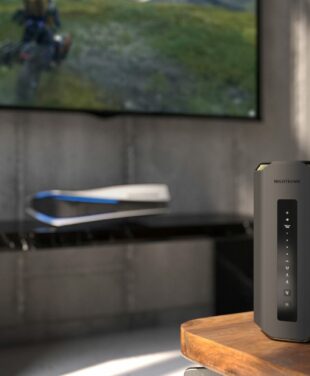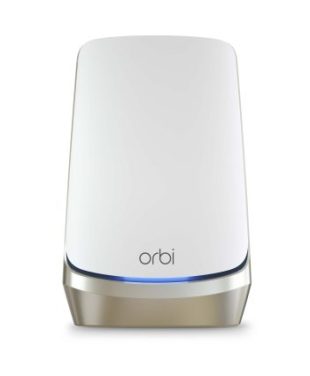Mesh WiFi systems are becoming very popular, and for good reason. They provide extensive coverage without the WiFi dead zones typical of traditional WiFi routers. But how do you set Mesh WiFi up? Let's break it down into simple steps.
IN THIS ARTICLE
Why Install a Mesh Network?
The typical WiFi router access point can deliver an adequate signal for a small household. However, not all homes are the same, and the design and building materials used can impede wireless connectivity. Anyone who has attempted to establish a WiFi connection at the edge of a router’s effective range will understand the frustration of latency issues, lag, spotty WiFi coverage, and connection dropouts. An average Australian home these days can have 20+ connected devices and smart home applications all needing to connect simultaneously.
For most people, the idea of everyone in the household coming together in one room clustered close to the router isn’t a workable solution. Appliances are getting smarter, while phones, tablets, and computers are getting data-hungry to the point where a single router may not be able to keep pace with data demands. A whole-home mesh WiFi system is the answer.
Mesh networks mitigate common connection problems by relaying router signal power from one satellite node to the next to create blanket WiFi coverage throughout the home, even in WiFi dead zones. In other words, everyone in your home can enjoy their own connected space, upstairs, downstairs, and even outdoors by the pool.
With a WiFi mesh system, you can move through your home with your device from one room to another without losing connectivity. Mesh satellites hand the connection over to one another, so you are assured of the strongest available signal at all times. In times when HD video streaming, multi-player gaming, big file downloading, and smart home apps are simultaneously vying for attention, mesh WiFi can handle everything stress-free.
The Basics of Mesh WiFi Setup
Setting up a mesh network at home isn’t difficult. You don’t need to be tech-savvy to set up a mesh router network that delivers the best WiFi signal strength and firmware performance possible. Straightforward mesh WiFi setup using a mobile app simply involves strategically placing the router satellite nodes throughout your home. High-performance dual-band, tri-band, and quad-band mesh WiFi network systems are changing the way Australians work and play. Your mesh network only requires one password, so unlike some WiFi extenders, you won’t have to log out and reconnect in different areas of your home. Here are three helpful mesh network ideas for the best results.
1. Map out your mesh network coverage
Before you start your mesh WiFi setup, remember that mesh node location is key for delivering faster speeds for your WiFi devices. Also, ensure you have a working internet connection, a good internet service provider (ISP), and a compatible modem. The next step is to locate WiFi dead zones in your home where you want the wireless router signal to reach. For example, your current router signal might adequately cover your first floor, but not upstairs. In this case, you would place a satellite node (pod) near a power point in the upstairs hallway.
A typical router or range extender offers greater line-of-sight coverage where the signal doesn’t pass through dense objects like brick walls. In most homes, a main router plus one or two satellite node mesh devices can be enough for the square feet of WiFi coverage required. The best whole-home mesh WiFi systems, such as NETGEAR Orbi 970, include multiple Ethernet ports on the main router and satellites. Connect devices directly to these LAN ports for optimising powerful throughput and backhaul performance.
2. Pick your pods and place them strategically
Once you’ve determined how many satellite nodes you need, you can purchase a mesh system that meets your wireless network requirements. Satellite node placement is a very important consideration when setting up your mesh network. The WiFi signal is passed from node to node, so they need to be able to communicate clearly and strongly with each other, with no interference. The best location is one where you have maximum WiFi reach. Here are some useful tips.
• Place your main access point router and modem close to the centre of your home and spread your local area network (LAN) out from there.
• For optimum performance, place satellites about halfway between the router and the dead zone you plan to cover.
• Place satellites in a way that the WiFi signal avoids having to penetrate walls, furniture, and other hard object obstructions.
• Satellite nodes connect to electrical outlets, and they can also be used for daisy-chaining with Ethernet cables.
• Nodes that need to reach through ceilings for device connections should be placed higher up, while nodes that need to reach through floors should be lower down.
• Understand the maximum wireless range of each satellite node, and plan node placement to be approximately two-thirds of that distance to ensure the signals overlap. You can always add more nodes to the network.
• Purchase a modern mesh WiFi system that minimises interference from devices such as microwaves, baby monitors, wireless headsets, etc. NETGEAR Orbi WiFi 6 and WiFi 7 products automatically switch from 2.4GHz to a quieter band (5GHz or 6GHz) for the best signal strength.
3. Activate your mesh network pods
Once you’ve placed your nodes and plugged them in, the entire mesh system can be activated using your smartphone app. Simply download the Orbi app and activate your satellite nodes. The app can be used to troubleshoot issues and name your satellites, such as ‘kitchen’ or ‘upstairs hallway’. Keep it simple and you won’t get confused if an issue arises. The entire setup can be completed in less than half an hour, and you are ready for streaming, gaming, and browsing the internet.
Step-by-Step Guide for Mesh WiFi Setup
Unbox and Power Up: Start by unboxing your Mesh nodes. Plug in your primary node to your modem and power it up.
Download the App: Most Mesh systems come with a dedicated app for easy setup. This is where NETGEAR Orbi shines with its user-friendly interface.
Follow the App Instructions: The app will guide you through the setup process. It’s as easy as following a recipe for your favourite dish.
Position Your Nodes: Place additional nodes around your home. Higher placement positions often work best.
Sync and Test: Sync the nodes and test the network. Walk around your home with a device to ensure you’re getting solid coverage everywhere.
When performing the initial setup, you will need to connect the main router node using an Ethernet cable. Then switch the system on and let it power up. You will be prompted to create a mesh network account and log in. Name or number each satellite node and connect them one at a time. Once connected, you can run a speed test and perform other analytics to establish the best available signal strength and system performance.
Common connectivity issues or weak signals are often fixed by repositioning a node or restarting the system. The beauty of Mesh systems is their flexibility and ease of troubleshooting. With a NETGEAR Orbi 970 mesh system app, you also get NETGEAR Armor encrypted WPA3 security and Strict Parental Controls to ensure everyone in your home network or guest network is fully protected from spam and malicious intruders at all times.
How to Optimise Your Mesh Network
Are you still experiencing buffering, lag, latency issues, or dead zones? Experiment by moving the satellite nodes to different locations around your home. Placing a node closer to your main router can strengthen your initial signal and boost the other pods that are farther away. Analysing your WiFi signal may also help. Most ISPs have an app that lets you see signal strength, connected devices, and internet speeds. You can also find third-party apps that analyse your home network speed and signal strength.
Many mesh networks optimise automatically and constantly monitor device connections to ensure the network is operating at peak performance. An optimised mesh WiFi network will offer seamless WiFi coverage throughout your entire home. Once you’re up and running, keep your network in top shape with regular updates and security checks. A little bit of maintenance goes a long way in ensuring a smooth online experience.
The NETGEAR Orbi 970 Quad-Band System Advantage
This system is a dream for those who want a fuss-free setup. With its intuitive app and clear indicators for optimal node placement, Orbi 970 takes the guesswork out of the equation. It’s about getting you online quickly and keeping you there. NETGEAR Orbi is superior WiFi 7, unlocking extraordinary power and unprecedented WiFi speeds from the basement to the rooftop. Orbi allows everyone under one roof to get on with their online activities uninterrupted.
The increased bandwidth and enhanced dedicated backhaul facilitate multi-gig speeds across all devices. Local area networks (LAN), wide area networks (WAN), and guest networks can all enjoy 360-degree whole-home coverage without buffering thanks to the innovative high-performance antenna design with beamforming. The Orbi mesh router 970 system allows you to connect up to 200 devices concurrently.
Standout features of the Orbi 970 include much faster download speeds, multi-link operation (MLO), and preamble puncturing for splitting channels to create stronger connections. Real-time immersive online experiences such as virtual reality, multi-player gaming, and the Metaverse are entirely possible with WiFi 7 Orbi 970.
Orbi uses patented quad-band WiFi 7 technology to create a blazing-fast superhighway between the router and satellites for a seamless WiFi experience. In addition, the 10 Gig Ethernet ports and internet port unlock the fastest internet speeds of today and tomorrow. Orbi 970 offers ultimate flexibility with both 10 Gig wired LAN port connectivity and unparalleled 10G WiFi.
FAQs
How many Mesh nodes do I need for my home?
It depends on the size of your home. Generally, one node for every two rooms is a good rule of thumb. The mesh WiFi signals should slightly overlap for the best possible internet coverage.
Can I extend my Mesh network in the future?
Absolutely! One of the great things about Mesh networks is their scalability. You can easily add more satellite nodes if you renovate your home and as your device connection needs grow.
How do I know if my devices are connected to the Mesh network?
Most systems have an app that shows which devices are connected and to which node they’re connected.
Can Mesh WiFi work with smart home devices?
It certainly can. Mesh WiFi is designed to support a multitude of devices, including smart home technology such as security systems, smart TVs, Amazon Alexa sound systems, and a whole lot more.




